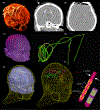RF-induced heating in tissue near bilateral DBS implants during MRI at 1.5 T and 3T: The role of surgical lead management
- PMID: 30243973
- PMCID: PMC6475594
- DOI: 10.1016/j.neuroimage.2018.09.034
RF-induced heating in tissue near bilateral DBS implants during MRI at 1.5 T and 3T: The role of surgical lead management
Abstract
Access to MRI is limited for patients with deep brain stimulation (DBS) implants due to safety hazards, including radiofrequency (RF) heating of tissue surrounding the leads. Computational models provide an exquisite tool to explore the multi-variate problem of RF heating and help better understand the interaction of electromagnetic fields and biological tissues. This paper presents a computational approach to assess RF-induced heating, in terms of specific absorption rate (SAR) in the tissue, around the tip of bilateral DBS leads during MRI at 64MHz/1.5 T and 127 MHz/3T. Patient-specific realistic lead models were constructed from post-operative CT images of nine patients operated for sub-thalamic nucleus DBS. Finite element method was applied to calculate the SAR at the tip of left and right DBS contact electrodes. Both transmit head coils and transmit body coils were analyzed. We found a substantial difference between the SAR and temperature rise at the tip of right and left DBS leads, with the lead contralateral to the implanted pulse generator (IPG) exhibiting up to 7 times higher SAR in simulations, and up to 10 times higher temperature rise during measurements. The orientation of incident electric field with respect to lead trajectories was explored and a metric to predict local SAR amplification was introduced. Modification of the lead trajectory was shown to substantially reduce the heating in phantom experiments using both conductive wires and commercially available DBS leads. Finally, the surgical feasibility of implementing the modified trajectories was demonstrated in a patient operated for bilateral DBS.
Keywords: Computational modeling and simulations; Deep brain stimulation (DBS); Finite element method (FEM); MRI safety; Magnetic resonance imaging (MRI); Medical implants; Neuromodulation; Neurostimulation; Specific absorption rate (SAR).
Copyright © 2018 Elsevier Inc. All rights reserved.
Figures









Similar articles
-
Reconfigurable MRI technology for low-SAR imaging of deep brain stimulation at 3T: Application in bilateral leads, fully-implanted systems, and surgically modified lead trajectories.Neuroimage. 2019 Oct 1;199:18-29. doi: 10.1016/j.neuroimage.2019.05.015. Epub 2019 May 13. Neuroimage. 2019. PMID: 31096058 Free PMC article.
-
Effect of surgical modification of deep brain stimulation lead trajectories on radiofrequency heating during MRI at 3T: from phantom experiments to clinical implementation.J Neurosurg. 2023 Nov 10;140(5):1459-1470. doi: 10.3171/2023.8.JNS23580. Print 2024 May 1. J Neurosurg. 2023. PMID: 37948679 Free PMC article.
-
Numerical Simulations of Realistic Lead Trajectories and an Experimental Verification Support the Efficacy of Parallel Radiofrequency Transmission to Reduce Heating of Deep Brain Stimulation Implants during MRI.Sci Rep. 2019 Feb 14;9(1):2124. doi: 10.1038/s41598-018-38099-w. Sci Rep. 2019. PMID: 30765724 Free PMC article.
-
Magnetic resonance imaging conditionally safe neurostimulation leads: investigation of the maximum safe lead tip temperature.Neurosurgery. 2014 Feb;74(2):215-24; discussion 224-5. doi: 10.1227/NEU.0000000000000242. Neurosurgery. 2014. PMID: 24176957 Review.
-
SAR Simulations & Safety.Neuroimage. 2018 Mar;168:33-58. doi: 10.1016/j.neuroimage.2017.03.035. Epub 2017 Mar 20. Neuroimage. 2018. PMID: 28336426 Review.
Cited by
-
Optimizing the trajectory of deep brain stimulation leads reduces RF heating during MRI at 3 T: Characteristics and clinical translation.Annu Int Conf IEEE Eng Med Biol Soc. 2023 Jul;2023:1-5. doi: 10.1109/EMBC40787.2023.10340979. Annu Int Conf IEEE Eng Med Biol Soc. 2023. PMID: 38083480 Free PMC article.
-
Segmenting electroencephalography wires reduces radiofrequency shielding artifacts in simultaneous electroencephalography and functional magnetic resonance imaging at 7 T.Magn Reson Med. 2022 Sep;88(3):1450-1464. doi: 10.1002/mrm.29298. Epub 2022 May 16. Magn Reson Med. 2022. PMID: 35575944 Free PMC article.
-
Development, validation, and pilot MRI safety study of a high-resolution, open source, whole body pediatric numerical simulation model.PLoS One. 2021 Jan 13;16(1):e0241682. doi: 10.1371/journal.pone.0241682. eCollection 2021. PLoS One. 2021. PMID: 33439896 Free PMC article. Clinical Trial.
-
Modeling and Measurement of Lead Tip Heating in Implanted Wires with Loops.ArXiv [Preprint]. 2024 Dec 19:arXiv:2412.15120v1. ArXiv. 2024. Update in: Phys Med Biol. 2025 Apr 22;70(9). doi: 10.1088/1361-6560/adcc73. PMID: 39764403 Free PMC article. Updated. Preprint.
-
Phantom Safety Assessment of 3 Tesla Magnetic Resonance Imaging in Directional and Sensing Deep Brain Stimulation Devices.Stereotact Funct Neurosurg. 2025;103(1):42-54. doi: 10.1159/000542725. Epub 2024 Nov 27. Stereotact Funct Neurosurg. 2025. PMID: 39602889 Free PMC article.
References
-
- Limousin P et al., “Effect on parkinsonian signs and symptoms of bilateral subthalamic nucleus stimulation,” The Lancet, vol. 345, no. 8942, pp. 91–95, 1995 - PubMed
-
- Benabid AL, “Deep brain stimulation for Parkinson’s disease,” Current opinion in neurobiology, vol. 13, no. 6, pp. 696–706, 2003. - PubMed
-
- Benabid AL, Chabardes S, Mitrofanis J, and Pollak P, “Deep brain stimulation of the subthalamic nucleus for the treatment of Parkinson’s disease,” The Lancet Neurology, vol. 8, no. 1, pp. 67–81, 2009. - PubMed
-
- Kumar R, Dagher A, Hutchison W, Lang A, and Lozano A, “Globus pallidus deep brain stimulation for generalized dystonia: clinical and PET investigation,” Neurology, vol. 53, no. 4, pp. 871-871, 1999. - PubMed
Publication types
MeSH terms
Grants and funding
LinkOut - more resources
Full Text Sources
Other Literature Sources
Medical
Miscellaneous

